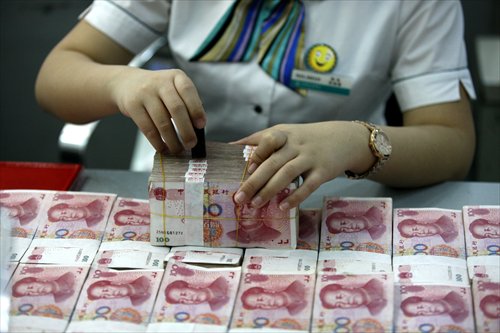US softens criticism of yuan valuation
Change prompted by appreciation in recent years: experts

A clerk counts banknotes at a branch of Agricultural Bank of China in Huaibei, East China's Anhui Province in August. Photo: CFP
The US Treasury has softened its tone of criticism on the Chinese yuan's exchange rate, and experts said Tuesday that this change in attitude is understandable as the yuan has appreciated significantly against the US dollar in the past 10 years.
Having previously described China's currency as being "significantly undervalued," the US Treasury said the yuan was "below its appropriate medium-term valuation," in its latest semi-annual report to the US Congress on global economic and exchange rate policies on Monday (US time).
The new evaluation shows a "softened" attitude from the US, as it has described the yuan as being significantly undervalued in every foreign exchange report since May 2012, according to a Bloomberg report published on Tuesday.
The US Treasury report also said that the "near-term trajectory" of the yuan is "difficult to assess," due to reasons such as "economic uncertainties, volatile capital flows and prospects for slower growth in China."
The People's Bank of China (PBC), China's central bank, did not respond to a request for an interview from the Global Times by press time.
Zhang Liqing, dean of the School of Finance at the Central University of Finance and Economics, told the Global Times on Tuesday that the yuan was undervalued to some extent before 2005. However, the yuan has appreciated more than 30 percent against the US dollar since then, Zhang noted, and this has prompted the US to adjust its position.
The change in the US attitude follows the Chinese government's recent efforts to allow a greater role for the market in setting the yuan's exchange rate. On August 11, the PBC announced a decision to adjust the system for fixing the yuan's central parity rate, in order to better reflect market forces in the yuan's exchange rate against the US dollar.
The PBC's announcement on August 11 caused the yuan to depreciate by about 2 percent against the US dollar that day, the biggest one-day slide in nearly two decades.
According to a report by US television channel CNBC on Tuesday, the US government offered a "cautious welcome" to the changes in China's exchange rate system, and it still believes that the yuan will strengthen in the longer term.
But the Treasury report also recognized that at the current stage, a number of factors are "exerting downward pressure" on the yuan, such as investors' concerns about China's slowing economy.
Zhong Dajun, director of the Beijing Dajun Institute for Economic Observation, told the Global Times on Tuesday that many speculative investors have started to hold pessimistic views on China's economic prospects and the yuan's future trend in recent months, leading to increased capital outflows and currency depreciation.
Capital outflows in China amounted to about $80 billion in July and $200 billion in August following the changes in the domestic exchange rate regime, and the central government has spent a large amount of money to support the yuan, the Treasury report noted.
Zhong nevertheless said that this phenomenon is transient, and that considering the relatively high domestic trade surplus at present, there should be "no grounds for long-term depreciation."
China's trade surplus amounted to 376 billion yuan ($59.3 billion) in September, up from 310 billion yuan during the same period in 2014.
Wang Yungui, director of the Comprehensive Department at the State Administration of Foreign Exchange (SAFE), said during a conference on September 17 that the yuan's exchange rate tends to be "stable" and that the depreciation pressure on the currency has been "eased," according to a statement from SAFE on the same day.
The US Treasury report also indicated that the yuan should respond properly not only to depreciation pressure, but also to the need for appreciation if such a need arises in the future, and called this an "indicator" of how responsive the new mechanism will be to market forces.